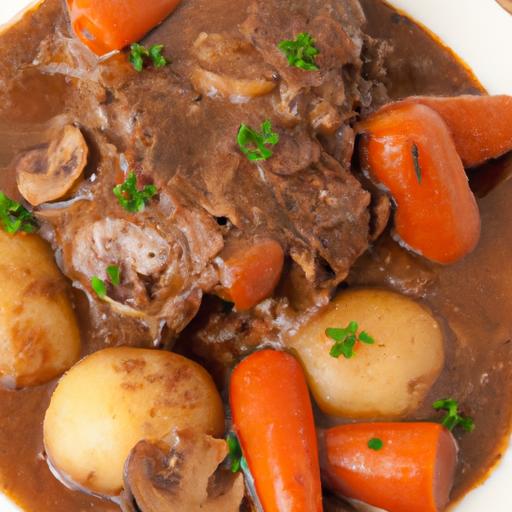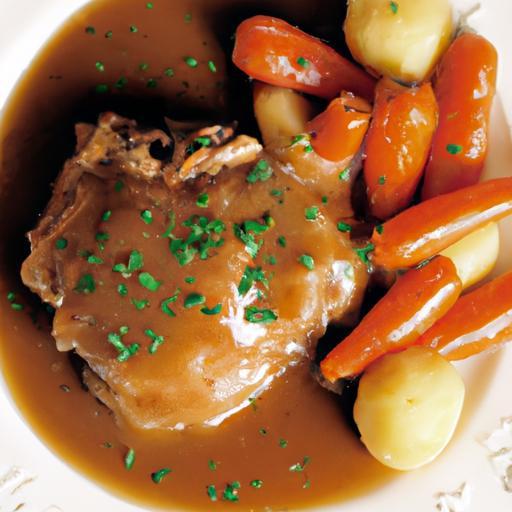There’s something deeply comforting about a smooth, velvety gravy cascading over a plate of roasted goodness. Yet, for many home cooks, that comforting drizzle is interrupted by an unwelcome surprise: lumps. Those stubborn clumps can turn a perfect meal into a culinary puzzle, leaving you wondering where it all went wrong. What causes gravy to veer off course, thickening into a bumpy mess instead of a luscious sauce? In this article, we’re diving spoon-first into the science and secrets behind lumpy gravy. Prepare to unravel the mystery and discover foolproof tips to reclaim that silky smoothness every time you cook.
Understanding the science behind why gravy becomes lumpy is the first step to perfecting this beloved sauce. When the flour or starch hasn’t been properly integrated or cooked at the right temperature, those frustrating lumps form. Gravy lumps happen because the starch molecules swell unevenly and clump together instead of dispersing smoothly, often due to uneven stirring or bursts of heat.
Common Culprits That Turn Your Gravy Grainy
Several factors can sabotage your smooth gravy dream. First, adding flour directly into hot fat without creating a proper roux causes uneven gelatinization. Second, pouring cold liquid too quickly onto hot roux can shock starch granules, causing clumps. Third, improper stirring or skipping the gradual addition of liquids leaves pockets of dry flour that cook inconsistently. Lastly, overheating or boiling the gravy aggressively can denature the thickening starch, leading to a grainy texture.
Mastering the Perfect Stir and Heat Control
The key to silky-smooth gravy lies in mastering temperature and technique. Begin by cooking your roux over medium heat, stirring constantly until it achieves a golden hue, which develops flavor and ensures starch molecules break down evenly. Next, temper your stock or liquid by warming it slightly-room temperature or just warmed-and add slowly in a steady stream, whisking vigorously to prevent lumps. Maintain a gentle simmer rather than a rolling boil; aggressive heat disrupts the starch network essential for smooth thickening. Consistent stirring with a whisk encourages uniform dispersion, encouraging luscious creaminess.
Expert Tips to Rescue and Prevent Lumpy Gravy
If lumps form, all is not lost. Strain the gravy through a fine mesh sieve or push it vigorously with a wooden spoon against the sides of a saucepan to break up clumps. For quick fixes, blend the gravy with an immersion blender to restore silkiness. Prevent future lumps by slowly incorporating liquid, constantly whisking, and avoiding pouring cold liquids directly into hot roux. Another secret is to combine flour with a small amount of cold liquid first, forming a smooth slurry before adding to hot fat or stock.
Prep and Cook Time
- Prep Time: 5 minutes
- Cook Time: 15 minutes
Yield
Approximately 4 servings
Difficulty Level
Medium
Ingredients
- 3 tbsp unsalted butter
- 3 tbsp all-purpose flour, sifted
- 2 cups warm chicken or beef stock
- ½ tsp salt
- ¼ tsp freshly ground black pepper
- 1 tsp Worcestershire sauce (optional)
- 1 tsp fresh thyme leaves (optional)
Instructions
- Melt the butter in a medium saucepan over medium heat until foaming but not browned.
- Whisk in the sifted flour immediately to form a smooth roux. Cook, stirring constantly, for about 3-5 minutes until it turns a light golden color but does not brown. This step removes the raw flour taste.
- Gradually pour in the warm stock in a slow, steady stream, whisking vigorously to combine and prevent lumps. Avoid adding it all at once.
- Bring the mixture to a gentle simmer while whisking constantly. Allow the gravy to thicken naturally, about 5 to 7 minutes. Do not boil vigorously.
- Season with salt, black pepper, Worcestershire sauce, and thyme if using. Stir to incorporate evenly.
- Adjust the consistency by adding more warm stock if too thick, whisking thoroughly to blend.
- Remove from heat and serve immediately, or keep warm on low heat, stirring occasionally to prevent a skin forming.
Chef’s Notes
- For gluten-free gravy, substitute all-purpose flour with cornstarch; whisk cornstarch into cold liquid first to form a slurry before adding to warm fat.
- If your gravy turns too thick, gradually whisk in extra warm stock or water to loosen the texture.
- Make-Ahead: Prepare the roux in advance, then quickly finish your gravy by adding warmed stock before serving.
- Use a balloon whisk for better aeration and lump prevention during stirring.
- Keep stirring during the cooking process to evenly distribute heat and avoid scorching on the bottom of the pan.
Serving Suggestions
Spoon your velvety gravy generously over roast meats, mashed potatoes, or stuffing for an indulgent comfort meal. Garnish with fresh chopped parsley or a sprig of thyme to add a vibrant burst of color and fresh herbal aroma. Pair with roasted vegetables or Yorkshire puddings for a classic feast. Consider a dash of cream for extra silkiness right before serving.

| Nutrition per Serving | Calories | Protein | Carbs | Fat |
|---|---|---|---|---|
| Gravy | 120 | 2g | 10g | 8g |
Discover more tips on achieving perfect sauces in our comprehensive gravy guide. For further scientific insight on thickening agents, visit ScienceDaily’s starch and thickener study.
Q&A
Q&A: Unraveling the Mystery: Why Is My Gravy Lumpy?
Q1: Why does my gravy sometimes turn out lumpy instead of smooth?
A1: Lumps in gravy often happen when the starch (like flour or cornstarch) isn’t evenly mixed with the fat before adding liquid. If the starch hits the hot liquid all at once or isn’t whisked well, it clumps together, creating those pesky lumps.
Q2: Can I fix lumpy gravy once it’s already cooked?
A2: Absolutely! If your gravy has lumps, try whisking it vigorously over low heat. For stubborn clumps, strain the gravy through a fine mesh sieve. Alternatively, using an immersion blender can quickly smooth things out like magic.
Q3: How can I prevent lumps from forming in the first place?
A3: The secret lies in technique. Start by making a roux-a paste of fat and flour cooked together-before adding liquid gradually while whisking constantly. Another trick is to mix your starch with a small amount of cold liquid to form a slurry and add it slowly to hot liquid, whisking continuously.
Q4: Does the type of thickener affect lumpiness?
A4: Yes! Flour tends to require more careful cooking and constant stirring to avoid lumps, while cornstarch, mixed into a slurry first, can be more forgiving. Each thickener has its quirks, so knowing how to handle your chosen one helps you dodge lumps every time.
Q5: Could temperature be the culprit behind lumpy gravy?
A5: Temperature plays a starring role. Adding starch directly to boiling liquid can cause instant clumping. Similarly, adding cold liquid too fast to a hot roux may shock the mixture. Aim for medium heat and add liquids gradually to keep your gravy silky smooth.
Q6: What’s the best tool to whisk my gravy?
A6: A good old-fashioned whisk is your gravy’s best friend-it evenly distributes the starch and liquid, preventing cluster formation. A balloon whisk works wonders, but a fork or even a hand mixer in a pinch can save the day.
Q7: Why does gravy thicken unevenly sometimes?
A7: Uneven thickening often results from inconsistent stirring or adding liquid too quickly. Hot spots in the pan can also cause some parts to thicken faster. Stir frequently and keep the heat moderate to ensure your gravy thickens uniformly.
Q8: Can lumps add texture or flavor, or should I always avoid them?
A8: While some textures are delightful, lumps in gravy are generally seen as a kitchen mishap rather than a culinary feature. They can feel grainy or doughy and distract from that velvety mouthfeel we crave. So, smooth is usually the way to go.
Q9: Is it okay to use instant gravy mixes to avoid lumps?
A9: Instant mixes can be convenient and often formulated to minimize lumps, but they might sacrifice some homemade charm and flavor depth. If you prefer the homemade route, mastering the technique is more rewarding and tastier.
Q10: What’s the biggest takeaway for perfect gravy consistency?
A10: Patience and gradual mixing combined with a whisk in hand will be your best friends. Take your time to blend starch and fat properly before adding liquids slowly, keep stirring, and adjust heat carefully. With those recipes in your pocket, lumps will be history!
Future Outlook
As we stir the final spoonful and watch the last of those pesky lumps dissolve into silky smoothness, it’s clear that understanding the why behind lumpy gravy is the first step to perfecting this classic sauce. With a pinch of patience, the right technique, and a dash of know-how, you can transform your gravy from clumpy chaos into a velvety masterpiece that elevates every meal. So next time your gravy threatens to rebel, remember: science and a little kitchen savvy are your best allies in unraveling the mystery of those lumps-and in serving up success, one luscious pour at a time.


